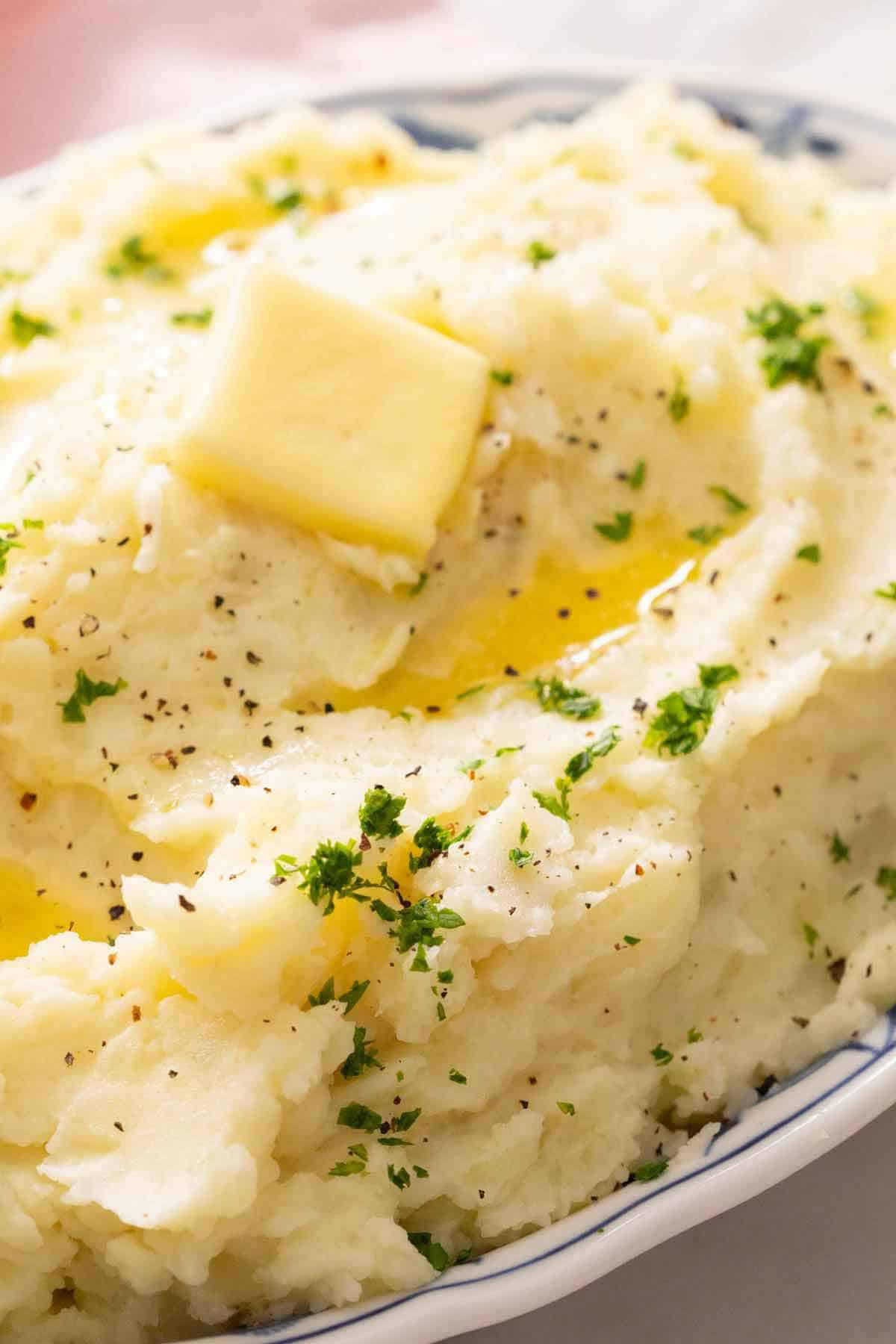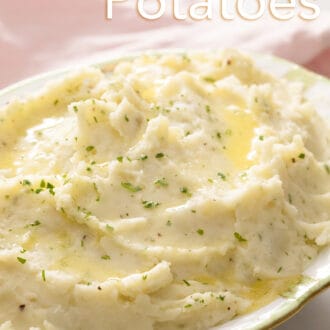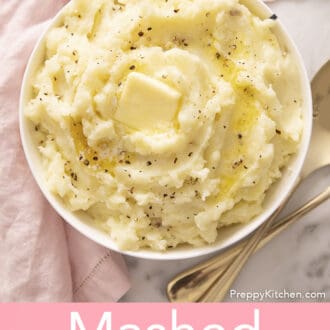Mashed potatoes are a popular comfort food for a reason. Buttery and creamy, this versatile side dish pairs so well with so many different kinds of food, from Salisbury steak to meatloaf, baked chicken legs, braised beef short ribs, and so much more!
If you’ve ever experienced mealy or watery mashed potatoes, rest assured that this easy recipe is foolproof to avoid those less-than-pleasant experiences! With my simple tips, they turn out creamy, velvety, and flavorful every time. Serve them with a large pat of butter and some black pepper, or use pan drippings from a roasted meat to whip up an easy gravy to smother them in.
Table of Contents
- Key Ingredients
- What Are The Best Potatoes To Use?
- Do I Have to Peel The Potatoes First?
- The Importance of Seasoning the Water
- Avoid Overworking The Potatoes
- Pro Tips For Making The Best Mashed Potatoes
- How To Make Mashed Potatoes
- Recipe Variations
- How To Store And Use Leftovers
- Make Ahead and Reheating Tips
- Frequently Asked Questions
Key Ingredients

It only takes a few simple ingredients to make the best mashed potatoes! You can find ingredient measurements in the recipe card below.
Potatoes — starchy potatoes like Yukon gold or Russet potatoes are my preference for fluffy mashed potatoes. Clean and scrub them well, especially if leaving the potato skins on.
Salt — salt is a must for seasoning the cooking water, which gives the potatoes so much flavor.
Garlic — while optional, I think garlic elevates this simple side dish. The cloves boil with the potatoes, seasoning them from the start.
Butter — mashed potatoes need fat for a creamy texture and rich flavor. Without it, the potatoes can seem watery or bland. I use unsalted butter, but you can also use salted butter. Just taste the mashed potato recipe before adding additional salt after mashing.
Milk — whole milk or heavy cream adds moisture and richness. You can also use half and half if you like!
What Are The Best Potatoes To Use?
For the best mashed potatoes recipe, I have found that starchy potatoes are by far the best option. During recipe testing, I found that these starchier potato varieties easily become fluffy and creamy when mashed, whereas more waxy varieties can turn gummy more easily.
I recommend Yukon gold potatoes or Russet potatoes. Russet potatoes have the highest starch content of the common potato varieties, so they become very light and fluffy when mashed. Yukon gold potatoes are considered an all-purpose potato, so they have a high enough starch content for this mashed potato recipe, and turn velvety when mashed.
You can use red potatoes if necessary, but since they are a type of waxy potato, they contain less starch and more moisture. Their texture is firmer when cooked, making them excellent for roasted potatoes, but harder to mash. This means they are more likely to be overworked and turn sticky or gummy. If you do use red potatoes, just keep this in mind and opt for chunkier mashed potatoes!

Do I Have to Peel The Potatoes First?
This is up to personal preference. Leaving all or some of the skins on will give the mashed potatoes more texture. If you want a smoother, creamier finish, remove the peels. Don’t forget to thoroughly scrub the peels if you opt to keep them on.
The Importance of Seasoning the Water
This is the secret to the best mashed potatoes! Like salting pasta water, seasoning the potato cooking water ensures the potatoes are seasoned all the way through.
While the potatoes boil, their starches absorb water. So any seasoning added to the water gets absorbed as well, leading to wonderfully flavorful potatoes. While all you technically need is a generous sprinkle of salt to season the water, I like to throw in a few cloves of garlic for a little something special. You can also replace some of the water with chicken broth or vegetable broth for an even richer flavor.
Avoid Overworking The Potatoes
Years of making mashed potatoes have taught me that there are a few parts of the process that are key to mashing up the creamiest potatoes and avoiding gummy mashed potatoes. They are easy, too! When potatoes are mixed, they start to release starches. The more they are mixed, the more starch is released, and when too much starch is released, the potatoes turn from creamy to gummy. You can see this difference in the image below. Follow these simple tips to enjoy perfectly fluffy and creamy potatoes every time:
- Mash while hot. That is, immediately after draining and evaporating the excess moisture. Potatoes can very easily turn gummy if mashed or mixed when cold. If they cool off, reheat them before mashing.
- Use warm milk and butter. Heat the mixture until the butter has melted or for 3–4 minutes. Stirring in warm ingredients prevents the potatoes from cooling down.
- Mash by hand. Avoid using a hand mixer or electric mixer, as they are prone to overworking the potatoes.

Pro Tips For Making The Best Mashed Potatoes
Start with cold water. This ensures that the cubed potatoes cook evenly as they boil, rather than being soft on the exterior but hard inside.
Don’t undercook the potatoes. The potatoes need to be fully cooked through to mash. You will know when they are done when you can easily pierce them with a fork.
Evaporate any excess water after draining. To ensure light and fluffy potatoes, heat the freshly drained potatoes over low heat for about one minute until any excess water has cooked off.
For velvety smooth potatoes, use a ricer or food mill. Press the hot boiled potatoes through a potato ricer or food mill before adding the butter and milk. This will result in fluffy, perfectly smooth mashed potatoes. I recommend peeling the potatoes for this method.
For chunky potatoes, mash until they are your desired consistency. You can keep large chunks by mashing less, or get mostly smooth potatoes by only leaving small chunks of potato throughout.
How To Make Mashed Potatoes

1. Clean and peel the potatoes, or leave the skins on if you prefer. Cut them into equal-sized large chunks. Add to a large pot.
2. Fill the pot with water so the potatoes are covered by 1 inch. Add 1 tablespoon of salt and peeled garlic cloves (if using).

3. Bring to a boil over high heat and cook for 10 minutes or until the potatoes are fork-tender.
4. Drain the potatoes and place them back in the cooking pot, then set the pot over low heat. Gently move the potatoes around to dry off excess water to prevent watery mashed potatoes. Remove from the heat and mash the hot potatoes with a potato masher or wooden spoon.

5. Meanwhile, in the last few minutes of potato cooking time, add the milk and butter to a small saucepan and place over medium heat. Stir occasionally while the potatoes finish cooking, until the butter melts, then remove from the heat.
6. Add the hot milk and butter mixture to the potatoes while gently mixing the mashed potatoes. Season with more salt and black pepper to taste and serve with more butter, black pepper, or minced fresh herbs like chives and parsley.

Mashed Potato Recipe
Video
Equipment
- Large Pot
- Strainer
- Wooden spoon or potato masher
Ingredients
- 4 pounds potatoes Yukon gold or Russet (1.8kg)
- 1 tablespoon salt plus more to taste
- 4 peeled garlic cloves optional
- ½ cup unsalted butter (113g)
- ¾ cup whole milk or cream (180ml)
- Ground black pepper to taste
Instructions
- Peel the potatoes if desired. Cut them into roughly 1-inch chunks and place in a large pot.
- Fill the pot with enough water to cover the potatoes by 1 inch. Add the salt and garlic cloves, if using, and bring to a boil over high heat. Cook for about 10 minutes or until the potatoes are fork-tender.
- While the potatoes are boiling, combine the milk and butter in a small saucepan. Cook over medium heat, stirring occasionally, for 3 to 4 minutes or until the butter is melted. Remove from the heat but keep warm if the potatoes aren’t done cooking.
- Drain the potatoes, then transfer them back to the warm pot. Set the heat to low and gently move them around for a minute to help dry off any excess water. Remove from heat and mash the potatoes to the desired consistency using a potato masher or wooden spoon.
- Pour the hot milk mixture in while gently mixing the mashed potatoes. Season with salt and pepper to taste. Serve with more butter and garnish with cracked pepper, minced chives, or parsley if desired.
Notes
- If you want more creaminess in your mashed potatoes, stir in ½ cup of sour cream or 4 ounces of softened cream cheese while mashing the potatoes. This gives them a delicious baked potato-style flavor and adds some extra richness without using more butter.
Nutrition
Recipe Variations
Garlic Mashed Potatoes: Double the amount of garlic cloves added to the pot when boiling the potatoes, or follow my garlic mashed potatoes recipe for extra garlic-packed flavor!
Cheesy Mashed Potatoes: Once the potatoes are mashed, gently stir in a package of Boursin cheese, ¾ cup of shredded cheese like fontina, gruyere, or sharp cheddar cheese, or ½ cup of finely grated parmesan or pecorino romano.
Use an Instant Pot: Make this recipe without a stovetop by cooking the potatoes in a pressure cooker! Instant Pot mashed potatoes are excellent to make when I need to free up space on the stovetop for other side dishes (perfect for big holiday meals!).
How To Store And Use Leftovers
Once completely cooled to room temperature, store leftovers in an airtight container in the refrigerator for 4 to 5 days.
You can enjoy them as-is or repurpose them! A few of my favorite ways to repurpose these potatoes are by making lefse (a savory Norwegian flatbread) or crisp-on-the-outside, fluffy-on-the-inside Duchess potatoes. They also make a great topping for Shepherd’s Pie and save you a few prep steps. Leftover mashed potatoes are also an excellent way to thicken soups! Just stir in about ¼ to ½ cup to give your soup more body.

Make Ahead and Reheating Tips
You can make this mashed potato recipe up to 48 hours in advance and store them in an airtight container or covered tightly in the fridge. They can be reheated in the oven, on the stovetop, or in a slow cooker depending on how you want to serve them.
Oven reheating: Refrigerate the prepared potatoes in a covered casserole dish. When ready to serve, let the pan sit out at room temperature for 30 minutes to 1 hour. Uncover and drizzle the potatoes with melted butter before baking in a 350°F oven for 20 minutes or until lightly golden on top.
Stovetop reheating: Place the chilled mashed potatoes in a medium pot with a splash of milk and reheat them on low heat for 5–10 minutes, stirring frequently, until creamy and hot again.
Slow-cooker reheating: Place the chilled mashed potatoes in a crock pot with a splash of milk. Turn on Low, stirring every 20 minutes or so, until hot, about an hour. Add extra milk during reheating as needed.
Frequently Asked Questions
Yes, you can freeze them. Once cooled completely, transfer the potatoes to a freezer-safe container or freezer bag with the air squeezed out and freeze for 1 month at most for the best texture. Defrost the potatoes overnight in the refrigerator before reheating.
If you’ve tried this best mashed potato recipe, then don’t forget to rate it and let me know how you got on in the comments below. I love hearing from you!















Karen says
Love the addition of the garlic in these potatoes. They were delicious!
John Kanell says
Thank you Karen!